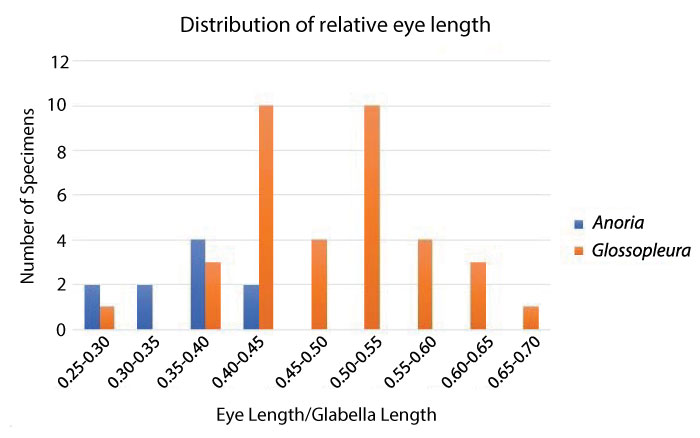FIGURE 1. Measurements taken of dolichometopid cephala for this study. Abbreviations: AGW, anterior glabella width; CW, cephalon width; EL, eye length; GL, glabella length; MGW, mid-glabella width; MOD, mid-ocular distance; PGW, posterior glabella width.

FIGURE 2. Relative eye position and length for dolichometopids measured in this study, showing low degree to which the studied specimens demonstrate large, posteriorly positioned eyes (toward upper right; historically features attributed to Glossopleura) or smaller, more anteriorly positioned eyes (toward lower left, normally attributed to Anoria and Sonoraspis). Data set equation shows a shallow slope and very weak correlation.

FIGURE 3. Relative eye position and length for dolichometopids in this study, by taxon and formation group (most traditional Glossopleura species blended). This version of the data shows the intermixing of Glossopleura and traditional Anoria and Sonorapis. Note that within taxa, eye position may vary greatly. Only eye length shows possible distinction between genera. Anoria tontoensis from the Bright Angel Formation (along with one specimen of A. bessus from the Gordon Shale) is smaller-eyed and separates from Glossopleura (including G. mckeei) but only at an arbitrary EL/GL of 0.380. A. lodensis, G. mohavensis, and S. californica all plot within Glossopleura.

FIGURE 4. Comparison of cranial measurements (in mm) in dolichometopids assigned to Glossopleura (blue), Sonoraspis (red), and Anoria (black). A) Eye length relative to glabella length. B) Eye position as represented by mid-ocular distance versus glabella length. Genera coded by color as noted above. Species denoted by symbols as listed alphabetically here: Glossopleura bion (filled blue squares), G. boccar (open blue diamonds), G. campbelli (open blue circles), G. gigantea (open blue ovals), G. lodensis (blue stars), G. mckeei (open blue triangles), G. mohavensis (blue dashes), G. producta (filled blue triangles), G. similaris (open inverted blue triangles), G. stephenensis (filled inverted blue triangles), G. utahensis (vertical blue bars), G. walcotti (filled blue diamonds), G. yatesi (filled blue circles); Sonoraspis californica (filled red squares), S. gomezi (open red squares), S. nelsoni (red pluses); Anoria baton (black pluses), A. bessus (black X), and A. tontoensis (filled black circles),

FIGURE 5. Distributions of EL/GL ratios for Glossopleura and Anoria specimens measured for this study. Individual generic and total-sample distributions are normal by Kolmogorov-Smirnov tests.

FIGURE 6. Anterior expansion of glabella in dolichometopids. A) Comparing AGW/MGW and AGW/PGW, showing Anoria and Sonoraspis less expanded but well mixed with Glossopleura specimens. B) Full data set statistics.

FIGURE 7. Principal components analysis of dolichometopid cranial measurements at genus level. Glossopleura = blue polygons. Sonoraspis = red polygons. Anoria = black polygons. A) PC1 vs PC2. B) PC1 vs PC3. C) PC2 vs PC3. Genera coded by color as noted above. Species denoted by symbols as listed alphabetically here: Glossopleura boccar (open blue squares), G. campbelli (open blue diamonds), G. lodensis (blue stars), G. mckeei (solid blue dots), G. mohavensis (blue dashes), G. producta (open blue triangles), G. similaris (vertical blue bars), G. stephenensis (open blue ovals), G. utahensis (inverted open blue triangles), G. walcotti (filled blue triangles), G. yatesi (filled inverted triangles); Sonoraspis californica (filled red circles), S. gomezi (filled red squares); Anoria baton (black X), A. bessus (open black circles), A. tontoensis (filled black squares).

FIGURE 8. Matrix characters for phylogenetic analysis shown on an unspecified species of dolichometopid trilobite (Glossopleura sp.). First number is character number (see Appendix for descriptions and matrix); number in parentheses is character state demonstrated by illustrated form. (Drawing courtesy of Sam Gon III.)

FIGURE 9. Phylogenetic analysis of 12 dolichometopid taxa for which there are relatively complete specimens, plus two outgroup taxa. A) Strict consensus of 40 MPTs of 41 steps. B) Strict consensus of 4 MPTs of 38 steps, after removal of the less well represented taxon G. bion. C) Strict consensus of 2 MPTs of 35 steps with just 8 dolichometopid taxa, after assuming the following synonymies: G. mckeei = G. boccar; S. californica = G. mohavensis; and G. producta = G. boccar. See text.

FIGURE 10. Dolichometopid trilobite specimens from the Cadiz Formation, California. A) Glossopleura lodensis (USNM 78400a), note eight thoracic segments, elongate T5 pleural spines, anteriorly expanded glabella, and long eyes (impression, lighting from left). B) Glossopleura mohavensis (USNM 78400b), note eight thoracic segments (dorsal exoskeleton, lighting from left). C) Glossopleura mohavensis (LACM 10785; “Sonoraspis californica”), note wide glabella, eight thoracic segments, and axial spine bases (impression, lighting from left). D) Glossopleura mohavensis (LACM 10786; “Sonoraspis californica”), note wide glabella, eight thoracic segments, and axial spine bases (impression, lighting from left). E) Glossopleura mohavensis (MWC 7769), note eight thoracic segments (dorsal exoskeleton, lighting from left). F) Glossopleura mohavensis (MWC 7779), (dorsal exoskeleton, lighting from left). A and B from the Bristol Mountains; C and D from near Section A of Foster (1994) (type section; north of Route 66), Marble Mountains; E and F from UCR 7359, near Section B of Foster (1994) (south of Route 66), Marble Mountains. All scale bars = 1 cm.

FIGURE 11. Some representative dolichometopids from other formations included in this study. A-B and D-E) Glossopleura boccar. C) Glossopleura similaris (?) F) Anoria tontoensis. G-H) Glossopleura mohavensis. A) USNM 62703, type of Glossopleura boccar, from the Stephen Formation. B) USNM 62702, specimen originally assigned to G. stephenensis, from the Stephen Formation. C) KUMIP 314054, G. similaris (?), from the Spence Shale (Langston Formation). D) SGDS 1975, G. boccar, from the Chisholm Formation. E) USNM 62714, specimen originally assigned to G. mckeei, from the Bright Angel Formation. F) USNM 62685, Anoria tontoensis, from the Bright Angel Formation. G) LACMIP 10782, specimen originally assigned to “Sonoraspis nelsoni”, from the Monola Formation. H) LACMIP 2469/24444.1, specimen originally assigned to “Sonoraspis californica”, from the Pole Canyon Formation. (Image in D courtesy of Andrew R.C. Milner. G and H courtesy LACM: Hendy, A., Walker, L., Mertz, W. [2020]. LACM Invertebrate Paleontology. Version 1.9. Natural History Museum of Los Angeles County. Occurrence dataset https://doi.org/10.15468/6nxzen accessed via GBIF.org on 2021-03-23.) All scale bars equal 1 cm.


